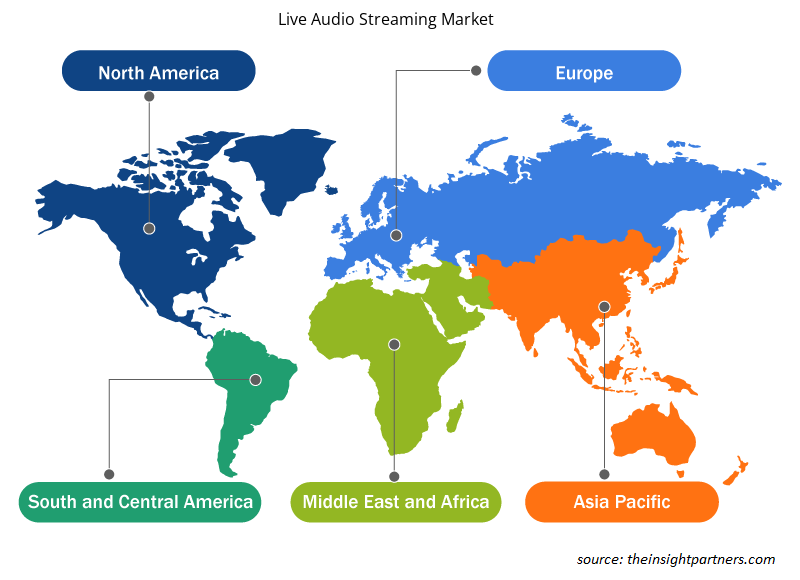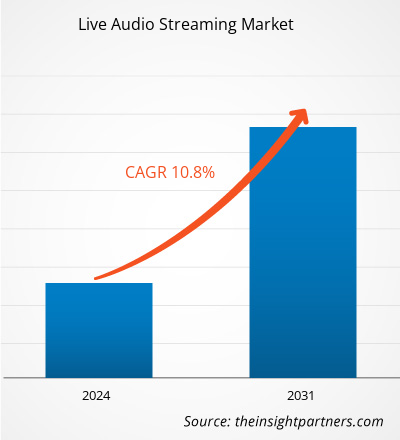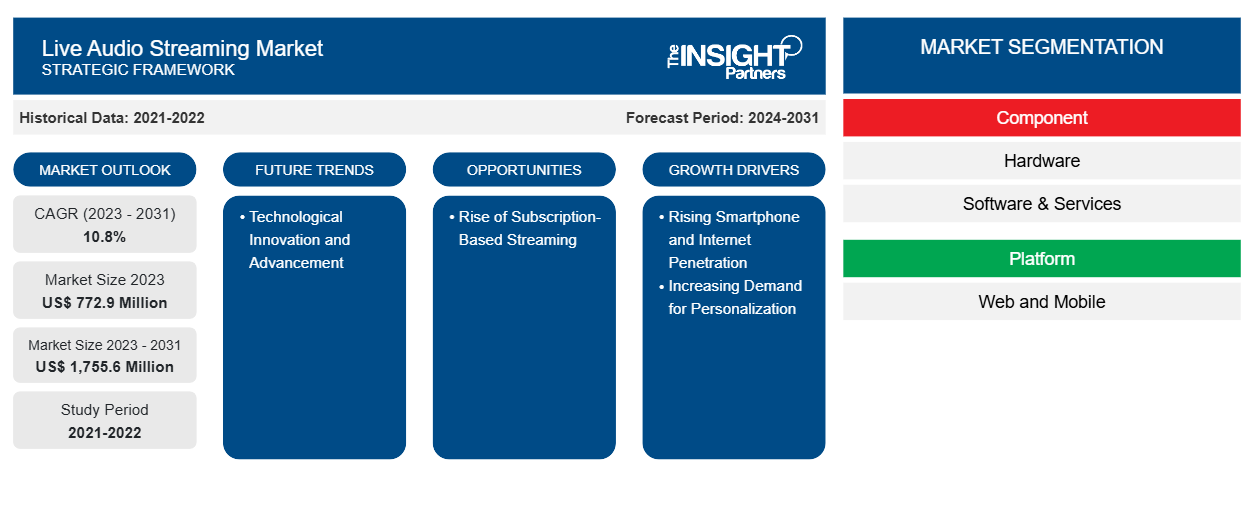Se proyecta que el tamaño del mercado de transmisión de audio en vivo alcance los 1.755,6 millones de dólares estadounidenses en 2031, frente a los 772,9 millones de dólares estadounidenses en 2023. Se espera que el mercado registre una CAGR del 10,8 % entre 2023 y 2031. Es probable que el aumento de la cantidad de teléfonos inteligentes y la creciente penetración de Internet sigan siendo tendencias clave del mercado de transmisión de audio en vivo.CAGR of 10.8% in 2023–2031. Rising smartphones and increasing internet penetration are likely to remain key live audio streaming market trends.
Análisis del mercado de transmisión de audio en vivo
Los servicios de streaming utilizan algoritmos sofisticados e inteligencia artificial para analizar los gustos de los usuarios, sus patrones de escucha y la información situacional, y ofrecen recomendaciones musicales personalizadas que se adaptan a las preferencias individuales. Las sugerencias musicales personalizadas y las listas de reproducción seleccionadas son fundamentales para captar el interés y la satisfacción de los usuarios. Este enfoque personalizado mejora la experiencia del usuario y lo mantiene comprometido con la plataforma.
Descripción general del mercado de transmisión de audio en vivo
La transmisión de audio en vivo es la transmisión en tiempo real de contenido de audio a través de una conexión de red, lo que permite la reproducción inmediata para la audiencia. Esta tecnología permite la transmisión en línea continua de grabaciones de sonido , como conferencias, podcasts y música, sin necesidad de descarga. Entrega contenido de audio a través de una conexión a Internet, lo que ofrece acceso directo al contenido transmitido y múltiples opciones para acceder al contenido en diferentes dispositivos. Al proporcionar conexiones y participación en tiempo real, la transmisión en vivo ha transformado la forma en que se experimentan los eventos globales, cambiando así nuestra perspectiva sobre el mundo. Además, las plataformas de transmisión de audio presentan oportunidades para generar ganancias a través de varios modelos de monetización, lo que las convierte en una opción atractiva para las empresas.
Personalice este informe según sus necesidades
Obtendrá personalización en cualquier informe, sin cargo, incluidas partes de este informe o análisis a nivel de país, paquete de datos de Excel, así como también grandes ofertas y descuentos para empresas emergentes y universidades.
-
Obtenga las principales tendencias clave del mercado de este informe.Esta muestra GRATUITA incluirá análisis de datos, desde tendencias del mercado hasta estimaciones y pronósticos.
Impulsores y oportunidades del mercado de transmisión de audio en vivo
La creciente penetración de los teléfonos inteligentes e Internet favorecerá al mercado
El uso de teléfonos inteligentes y redes sociales es común en la mayoría de las economías emergentes, lo que indica un cambio global hacia el uso de teléfonos inteligentes y la accesibilidad a Internet. La amplia disponibilidad de teléfonos inteligentes avanzados y la conectividad a Internet ha llevado a un número cada vez mayor de usuarios a elegir servicios de transmisión en línea. En enero de 2024, el número de usuarios móviles únicos alcanzó los 5.610 millones, y los teléfonos inteligentes constituyen aproximadamente el 85 por ciento de los teléfonos móviles en uso en todo el mundo. Una parte cada vez mayor de los usuarios que no tienen banda ancha atribuyen su decisión de renunciar a una suscripción a Internet de alta velocidad en el hogar a su dependencia de los teléfonos inteligentes para diversas actividades en línea. El tráfico de datos celulares ha aumentado constantemente, y el consumo promedio mensual de datos celulares por el usuario típico de teléfonos inteligentes en todo el mundo muestra un crecimiento significativo. El tráfico de Internet móvil contribuye a casi el 60 por ciento del tráfico web total, lo que indica el impacto sustancial de los dispositivos móviles en el uso de Internet.
El auge del streaming basado en suscripción
La tendencia de los consumidores a optar por suscripciones pagas para la reproducción de música sin publicidad, la escucha sin conexión, una mayor calidad de audio y contenido exclusivo está en aumento. Esta tendencia está influenciada por la economía bajo demanda, donde los consumidores conectados están dispuestos a pagar por la comodidad y el acceso inmediato a productos y servicios. La facilidad, la asequibilidad y la propuesta de valor que ofrecen los modelos de suscripción son los impulsores clave de esta tendencia. Los modelos de suscripción ofrecen a los consumidores comodidad y flexibilidad, mientras que las empresas se benefician de un flujo continuo de ingresos y la capacidad de recopilar datos sobre los patrones de uso de los clientes. Estos datos se pueden utilizar para mejorar el producto o servicio, en línea con las crecientes expectativas de los clientes de acceso bajo demanda y envío en el mismo día. Se espera que todos los factores impulsen el crecimiento del mercado de transmisión de audio en vivo.
Análisis de segmentación del informe de mercado de transmisión de audio en vivo
Los segmentos clave que contribuyeron a la derivación del análisis del mercado de transmisión de audio en vivo son el componente, la plataforma y la aplicación.
- Según los componentes, el mercado se divide en hardware y software y servicios. El segmento de software y servicios tuvo una participación de mercado significativa en 2023.
- Por plataforma, el mercado está segmentado en web y móvil. El segmento móvil tuvo una participación sustancial del mercado en 2023.
- En términos de aplicación, el mercado está segmentado en empresas, radio, conciertos y eventos musicales, particulares y otros. El segmento de la radio ocupó una parte sustancial del mercado en 2023.
Análisis de la cuota de mercado de la transmisión de audio en directo por geografía
El alcance geográfico del informe del mercado de transmisión de audio en vivo se divide principalmente en cinco regiones: América del Norte, Asia Pacífico, Europa, Medio Oriente y África, y América del Sur/América del Sur y Central.
El mercado de streaming de audio en vivo en América del Norte ha experimentado un crecimiento sustancial y se espera que continúe expandiéndose en los próximos años. Se espera que el mercado de streaming en vivo en América del Norte tenga una participación destacada, caracterizada por la presencia de importantes empresas de tecnología, una infraestructura de Internet avanzada y una gran base de consumidores con alta conectividad digital. La accesibilidad generalizada a la conectividad a Internet y la creciente dependencia de los navegadores web para varias actividades, incluida la transmisión de música basada en navegador , contribuyen al crecimiento del mercado en la región.
Perspectivas regionales del mercado de transmisión de audio en vivo
Los analistas de Insight Partners explicaron en detalle las tendencias y los factores regionales que influyen en el mercado de transmisión de audio en vivo durante el período de pronóstico. Esta sección también analiza los segmentos y la geografía del mercado de transmisión de audio en vivo en América del Norte, Europa, Asia Pacífico, Medio Oriente y África, y América del Sur y Central.

- Obtenga datos regionales específicos para el mercado de transmisión de audio en vivo
Alcance del informe sobre el mercado de transmisión de audio en vivo
| Atributo del informe | Detalles |
|---|---|
| Tamaño del mercado en 2023 | US$ 772,9 millones |
| Tamaño del mercado en 2031 | US$ 1.755,6 millones |
| CAGR global (2023 - 2031) | 10,8% |
| Datos históricos | 2021-2022 |
| Período de pronóstico | 2024-2031 |
| Segmentos cubiertos |
Por componente
|
| Regiones y países cubiertos |
América del norte
|
| Líderes del mercado y perfiles de empresas clave |
|
Densidad de actores del mercado: comprensión de su impacto en la dinámica empresarial
El mercado de transmisión de audio en vivo está creciendo rápidamente, impulsado por la creciente demanda de los usuarios finales debido a factores como la evolución de las preferencias de los consumidores, los avances tecnológicos y una mayor conciencia de los beneficios del producto. A medida que aumenta la demanda, las empresas amplían sus ofertas, innovan para satisfacer las necesidades de los consumidores y aprovechan las tendencias emergentes, lo que impulsa aún más el crecimiento del mercado.
La densidad de actores del mercado se refiere a la distribución de las empresas o firmas que operan dentro de un mercado o industria en particular. Indica cuántos competidores (actores del mercado) están presentes en un espacio de mercado determinado en relación con su tamaño o valor total de mercado.
Las principales empresas que operan en el mercado de transmisión de audio en vivo son:
- Adobe Inc.
- Bloomberg LP
- DACAST
- Grupo de difusión de Lime
- LINEAPP GmbH
- En vivo365
Descargo de responsabilidad : Las empresas enumeradas anteriormente no están clasificadas en ningún orden particular.

- Obtenga una descripción general de los principales actores clave del mercado de transmisión de audio en vivo
Noticias y desarrollos recientes del mercado de transmisión de audio en vivo
El mercado de transmisión de audio en vivo se evalúa mediante la recopilación de datos cualitativos y cuantitativos a partir de investigaciones primarias y secundarias, que incluyen publicaciones corporativas importantes, datos de asociaciones y bases de datos. A continuación, se incluye una lista de los avances del mercado:
- FOX News Audio ha ampliado su asociación con Audacy para incluir FOX Weather, el servicio de televisión por streaming gratuita y con publicidad (“FAST”) de FOX News Media. A partir del 1 de noviembre, el acuerdo ampliará la relación existente de FOX News Audio con Audacy, que también distribuye FOX News Podcasts y las transmisiones de audio de FOX News Talk.
(Fuente: FOX News Audio, sitio web de la empresa, 2024)
Informe sobre el mercado de transmisión de audio en vivo: cobertura y resultados
El informe “Tamaño y pronóstico del mercado de transmisión de audio en vivo (2023-2031)” proporciona un análisis detallado del mercado que cubre las siguientes áreas:
- Tamaño del mercado y pronóstico a nivel global, regional y nacional para todos los segmentos clave del mercado cubiertos bajo el alcance
- Dinámica del mercado, como impulsores, restricciones y oportunidades clave
- Principales tendencias futuras
- Análisis detallado de las cinco fuerzas de Porter y PEST y FODA
- Análisis del mercado global y regional que cubre las tendencias clave del mercado, los principales actores, las regulaciones y los desarrollos recientes del mercado.
- Análisis del panorama de la industria y de la competencia que abarca la concentración del mercado, el análisis de mapas de calor, los actores destacados y los desarrollos recientes
- Perfiles detallados de empresas
- Análisis histórico (2 años), año base, pronóstico (7 años) con CAGR
- Análisis PEST y FODA
- Tamaño del mercado, valor/volumen: global, regional y nacional
- Industria y panorama competitivo
- Conjunto de datos de Excel
Informes recientes
Informes relacionados
Testimonios
Razón para comprar
- Toma de decisiones informada
- Comprensión de la dinámica del mercado
- Análisis competitivo
- Información sobre clientes
- Pronósticos del mercado
- Mitigación de riesgos
- Planificación estratégica
- Justificación de la inversión
- Identificación de mercados emergentes
- Mejora de las estrategias de marketing
- Impulso de la eficiencia operativa
- Alineación con las tendencias regulatorias























 Obtenga una muestra gratuita para - Mercado de transmisión de audio en vivo
Obtenga una muestra gratuita para - Mercado de transmisión de audio en vivo